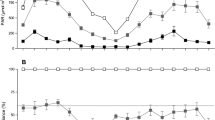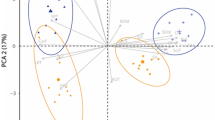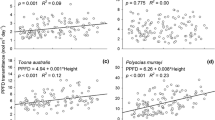Abstract
Light climates strongly influence plant architecture and mass allocation. Using the metamer concept, we quantitatively described branching architecture and growth of Chenopodium album plants grown solitarily or in a dense stand. Metamer is a unit of plant construction that is composed of an internode and the upper node with a leaf and a subtended axillary bud. The number of metamers on the main-axis stem increased with plant growth, but did not differ between solitary and dense-stand plants. Solitary plants had shorter thicker internodes with branches larger in size and number than the plant in the dense stand. Leaf area on the main stem was not different. Larger leaf area in solitary plants was due to a larger number of leaves on branches. Leaf mass per area (LMA) was higher in solitary plants. It did not significantly differ between the main axis and branches in solitary plants, whereas in the dense stand it was smaller on branches. Dry mass was allocated most to leaves in solitary plants and to stems in the dense stand in vegetative growth. Reproductive allocation was not significantly different. Branch/main stem mass ratio was higher in solitary than dense-stand plants, and leaf/stem mass ratio higher in branches than in the main axis. Nitrogen use efficiency (NUE) (dry mass growth per unit N uptake) was higher and light use efficiency (LUE) (dry mass growth per unit light interception) was lower in the plant grown solitarily than in the dense stand.






Similar content being viewed by others
References
Anten NPR, Hirose T (1998) Biomass allocation and light partitioning among dominant and subordinate individuals in Xanthium canadense stands. Ann Bot 82:665–673
Anten NPR, Hirose T (1999) Interspecific differences in aboveground growth patterns result in spatial and temporal partitioning of light among species in tall-grass meadow. J Ecol 87:583–597
Anten NPR, Schieving F, Medina E, Werger MJA, Schuffelen P (1995) Optimal leaf area indices in C3 and C4 mono- and dicotyledonous species at low and high nitrogen availability. Physiol Plant 95:541–550
Ballaré CL (1999) Keeping up with the neighbours: phytochrome sensing and other signalling mechanisms. Trends Plant Sci 4:97–102
Barlow PW (1989) Meristems, metamers and modules and the development of shoot and root systems. Biol J Linn Soc 100:255–279
Barthélémy D, Caraglio Y (2007) Plant architecture: a dynamic, multilevel and comprehensive approach to plant form, structure and ontogeny. Ann Bot 99:375–407
Berendse F, Aerts R (1987) Nitrogen-use-efficiency: a biologically meaningful definition? Funct Ecol 1:293–296
Björkman O (1981) Responses to different quantum flux densities. In: Lange OL, Nobel PS, Osmond CB, Ziegler H (eds) Encyclopedia of plant physiology, new series 12A. Springer, Berlin Heidelberg New York, pp 57–107
Boerner REJ (1984) Foliar nutrient dynamics and nutrient use efficiency of four deciduous tree species in relation to site fertility. J Appl Ecol 21:1029–1040
Field C (1983) Allocating leaf nitrogen for the maximization of carbon gain: leaf age as a control on the allocation program. Oecologia 56:341–347
Forster BP, Franckowiak JD, Lundqvist U, Lyon J, Pitkethly I, Thomas WTB (2007) The barley phytomer. Ann Bot 100:725–733
Fourcaud T, Zhang X, Stokes A, Lambers H, Körner C (2008) Plant growth modelling and applications: the increasing importance of plant architecture in growth models. Ann Bot 101:1053–1063
Fournier C, Andrieu B (2000a) Dynamics of the elongation of internodes in maize (Zea mays L.): analysis of phases of elongation and their relationships to phytomer development. Ann Bot 86:551–563
Fournier C, Andrieu B (2000b) Dynamics of the elongation of internodes in maize (Zea mays L.): effects of shade treatment on elongation patterns. Ann Bot 86:1127–1134
Givnish TJ (1982) On the adaptive significance of leaf height in forest herbs. Am Nat 120:353–381
Givnish TJ (1995) Plant stems: biomechanical adaptation for energy capture and influence on species distribution. In: Gartner BL (ed) Plant stems: physiology and functional morphology. Academic Press, San Diego, pp 3–49
Hikosaka K, Terashima I, Katoh S (1994) Effects of leaf age, nitrogen nutrition and photon flux density on the distribution of nitrogen among leaves of a vine (Ipomea tricolor Cav.) grown horizontally to avoid mutual shading. Oecologia 97:451–457
Hikosaka K, Sudoh S, Hirose T (1999) Light acquisition and use of individuals competing in a dense stand of an annual herb, Xanthium canadense. Oecologia 118:388–396
Hikosaka K, Yamano H, Nagashima H, Hirose T (2003) Light-acquisition and use of individuals as influenced by elevated CO2 in even-aged monospecific stands of Chenopodium album. Func Ecol 17:786–795
Hirose T (1971) Nitrogen turnover and dry matter production in a Solidago altissima population. Jpn J Ecol 21:18–32
Hirose T (1978) Dry matter production and nitrogen uptake relationships in buckwheat plants. Jpn J Ecol 28:25–34
Hirose T, Bazzaz FA (1998) Trade-off between light and nitrogen use efficiency in canopy photosynthesis. Ann Bot 82:195–202
Hirose T, Werger MJA (1987) Maximizing daily canopy photosynthesis with respect to the leaf nitrogen allocation pattern in the canopy. Oecologia 72:520–526
Hirose T, Werger MJA (1995) Canopy structure and photon flux partitioning among species in a herbaceous plant community. Ecology 76:466–474
Hirose T, Werger MJA, Pons TL, Rheenen JWA (1988) Canopy structure and leaf nitrogen distribution in a stand of Lysimachia vulgaris L. as influenced by stand density. Oecologia 77:145–150
Iwasa Y, Cohen D, Leon JA (1984) Tree height and crown shape, as results of competitive games. J Theor Biol 112:279–297
Jones HG (1992) Plants and microclimate, 2nd edn. Cambridge Univ Press, Cambridge
King D, Loucks OL (1978) The theory of tree bole and branch form. Rad Environ Biophys 15:141–165
Kobayashi S (1975) Growth analysis of plant as an assemblage of internodal segments. Jpn J Ecol 25:61–70
Küppers M (1989) Ecological significance of aboveground architectural patterns in woody plants: a question of cost-benefit relationships. Trends Ecol Evol 4:375–379
McMahon T (1973) Size and shape in biology. Science 179:1201–1204
McSteen P, Leyser O (2005) Shoot branching. Annu Rev Plant Biol 56:353–374
Monsi M, Saeki T (1953) Über den Lichtfaktor in den Pflanzengesellschaften und seine Bedeutung für die Stoffproduktion. Jpn J Bot 14:22–52
Monsi M, Uchijima Z, Oikawa T (1973) Structure of foliage canopies and photosynthesis. Annu Rev Ecol Syst 4:301–327
Monteith JL (1977) Climate and the efficiency of crop production in Britain. Phil Trans R Soc Lond B Biol Sci 281:277–294
Monteith JL, Unsworth MH (1990) Principles of environmental physics, 2nd edn. Edward Arnold, London
Nagashima H, Terashima I (1995) Relationships between height, diameter and weight distributions of Chenopodium album plants in stands: effects of dimension and allometry. Ann Bot 83:501–507
Niklas K (1992) Plant biomechanics: an engineering approach to plant form and function. Univ Chicago Press, Chicago
Niklas K (1994) The allometry of safety-factors for plant height. Am J Bot 81:345–351
Niklas K (1995) Plant height and properties of some herbaceous stems. Ann Bot 75:133–142
Oguchi R, Hikosaka K, Hirose T (2003) Does the photosynthetic light-acclimation need change in leaf anatomy? Plant Cell Environ 26:505–512
Room PM, Maillette L, Hanan JS (1994) Module and metamer dynamics and virtual plants. Adv Ecol Res 25:105–157
Shinozaki K, Yoda K, Hozumi K, Kira T (1964) A quantitative analysis of plant form––the pipe model theory. Jpn J Ecol 14:97–105
Smith H (2000) Phytochromes and light signal perception by plants––an emerging synthesis. Nature 407:585–591
Vitousek PM (1982) Nutrient cycling and nutrient use efficiency. Am Nat 119:553–572
Weiner J, Fishman L (1994) Competition and allometry in Kochia scoparia. Ann Bot 73:263–271
Weiner J, Thomas SC (1992) Competition and allometry in three species of annual plants. Ecology 73:648–656
Westoby M, Falster DS, Moles AT, Vest PA, Wright IJ (2002) Plant ecological strategies: some leading dimensions of variation between species. Annu Rev Ecol Syst 33:125–159
White J (1979) The plant as a metapopulation. Annu Rev Ecol Syst 10:109–145
White J (1984) Plant metamerism. In: Dirzo R, Sarukhan J (eds) Perspectives on plant population ecology. Sinauer, Sunderland, pp 15–47
Acknowledgments
We thank anonymous reviewers for comments on an earlier version of this paper. Technical supports from the staff members and students of the Laboratory for Agricultural Environmental Studies, Tokyo University of Agriculture, are gratefully acknowledged. This study was supported in part by the Grants-in-Aid from the Japan Society for the Promotion of Science to TH (no. 17370008, 20370015).
Author information
Authors and Affiliations
Corresponding author
About this article
Cite this article
Nishimura, E., Suzaki, E., Irie, M. et al. Architecture and growth of an annual plant Chenopodium album in different light climates. Ecol Res 25, 383–393 (2010). https://doi.org/10.1007/s11284-009-0666-6
Received:
Accepted:
Published:
Issue Date:
DOI: https://doi.org/10.1007/s11284-009-0666-6




